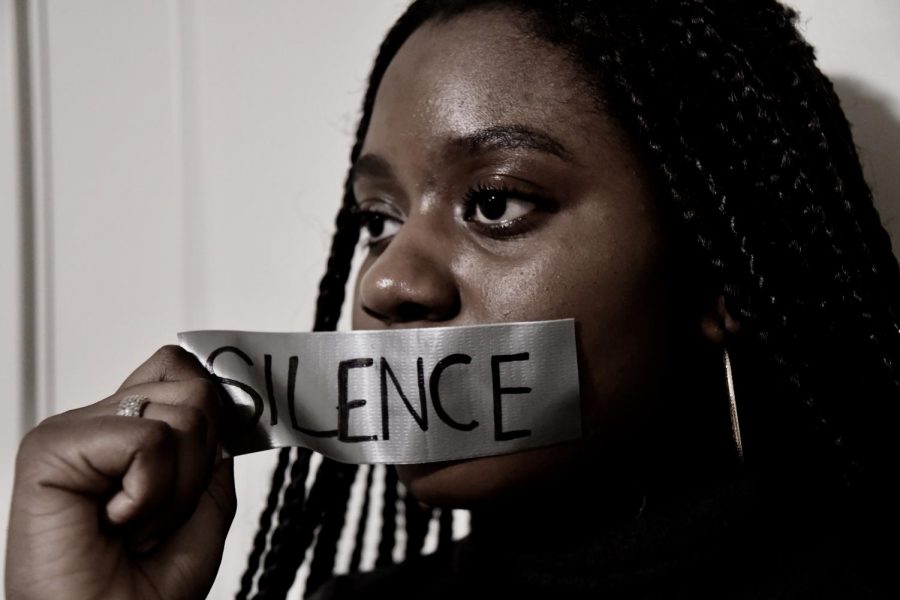Working to Reduce Red Dots, La Salle Begins Schoolwide Training for Bystander Intervention
Souria Luyamba, senior, who participated in the Green Dot training, illustrates a major goal of this program, which is encouraging people to stop being silent when they witness something bad happening.
November 29, 2017
Sexual harassment, bullying, stalking: these acts of violence or intimidation occur every day in high schools and colleges around the U.S. So many situations like these take place because no one is willing to say anything, and people are often hurt because others can’t or won’t step in. To try to prevent these things from happening, La Salle is now putting into place a system that aims to address this problem.
The Green Dot program is a relatively new idea, having previously been used in colleges and universities. However, it’s now beginning to be integrated in high schools. La Salle, along with other Catholic schools in the Portland area, are starting the process of implementing it this year. The goal is to prevent, minimize, and ultimately stop any power-based violence or abuse. This kind of abuse can materialize in many different ways; the program is meant to show bystanders how they can safely intervene and help.
It works like this: in areas of the school where a wrongdoing has occurred, a red dot will appear on a hypothetical map. Where something has been done to stop that abuse, or where someone has intervened, a green dot appears instead. The program is designed to empower students to act out in situations they may encounter. With Green Dot, students learn to intervene instead of being bystanders, and they learn how they can effectively and safely fight back in previously daunting situations.
“While La Salle doesn’t have any huge problems, every school has issues,” explains Mr. Devenney, one leader of the project. This program is being put into place in part to solve those problems but also as a preventative measure to stop future instances of these things occurring.
Implementing the program is a several stage process. The first step was training the staff. The leaders of the program, Mrs. Schuster, Mr. Devenney, and Mr. Altshuler, accomplished this in an all-staff training by raising awareness of what the program means and why it is important, leading conversations about what it covers, and looking at the issues that currently affect our school and our community.
“The goal of the program is to create an atmosphere where bystanders are empowered to stop things like sexual harassment, bullying, or any example of someone taking advantage of somebody else,” says Mr. Devenney. Part of creating that atmosphere is creating comfortable places to talk honestly about these problems.
The next step, accomplished last month, was gathering a starting group of around twenty seniors to go through the program. These student leaders were the first to go through the program. The meetings mainly focused on discussions and real world problems: how to deal with dangerous situations, how to reach out for help, and how our community can find ways to deal with power-based violence.
One senior, Hannah Sisul, believes that this is a good start for La Salle. “As a senior going away to college, where sexual assault and violence is more prevalent, I was super excited I was able to learn about some of these things before going away. I think having more students involved will help a lot, because even just helping out someone getting bullied in the hallway is a step towards ending this violence in schools.”
Another student, Emily Miller, adds that Green Dot acknowledges that there are problems at La Salle and other Catholic schools, and helps bring awareness to these difficulties. “[Avoiding these problems] does nothing for us as a community. Instead, we need to recognize it and address it in a way that makes people feel comfortable, including ourselves.”
Seniors and juniors are being trained this year; however, the ultimate goal is for everyone to become a part of the program. “Everyone should feel like they can be part of the solution and that they can engage in being an active bystander,” says Mrs. Schuster. Next year, the program will begin to become integrated into Health 2 classes.
Despite the program normally using a volunteer system, La Salle has chosen to try to incorporate it into classes instead. “It’ll be experimental,” Mr. Devenney explains. “If it turns out that’s not the right place to be, we’ll adjust, and we’ll put it in the right place.” Many parts of the program can and likely will be changed based off of student feedback.
In order for the program to work, everyone has to work with it. People will need to dedicate time and effort to being open and honest about what happens in their lives. Mr. Altshuler, one of the leaders of the program, claims that, “I think there has to be a commitment, and I think there has to be a commitment from people from all different walks of life.” He believes that students have to be willing to speak for themselves and say: “‘I’m going to concern myself with what’s right and commit to that.’” It’s a tough stance to take, and Mr. Altshuler says that it will take courage and dedication from our community to accomplish this.
Victims of assault often feel silenced or even guilty about what’s happened to them, and victim blaming can be extremely prevalent. “It’s our responsibility to create an atmosphere where that doesn’t happen,” says Mr. Devenny. He notes that it isn’t one person’s responsibility to keep themselves safe; it’s the community’s responsibility to keep everyone safe.
“My hope is that everyone chips in and realizes that we all have a responsibility to keep our community safe and progressive,” Mr. Altshuler said.





